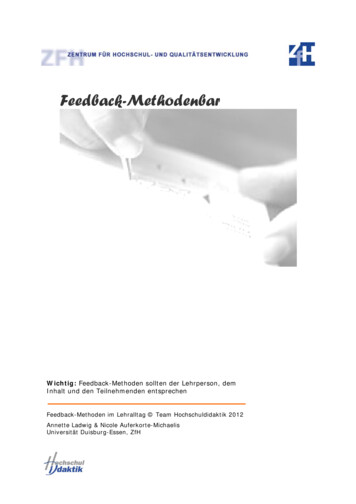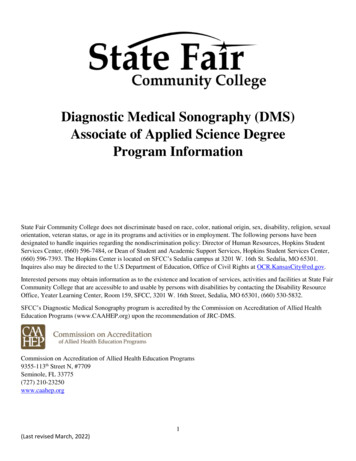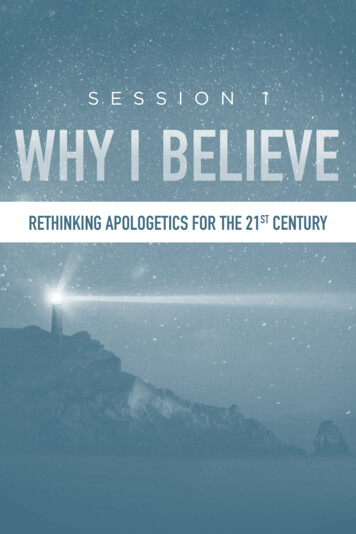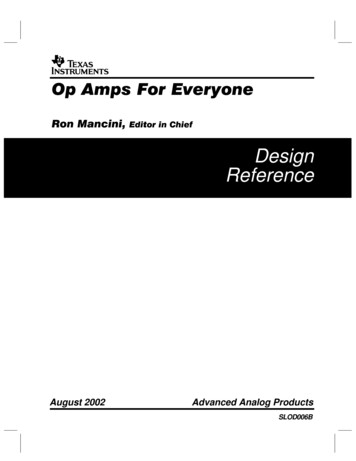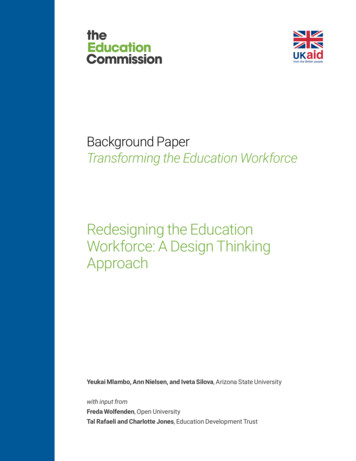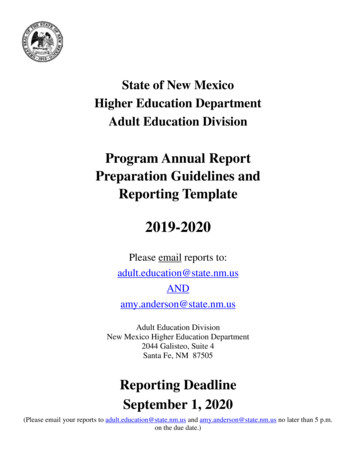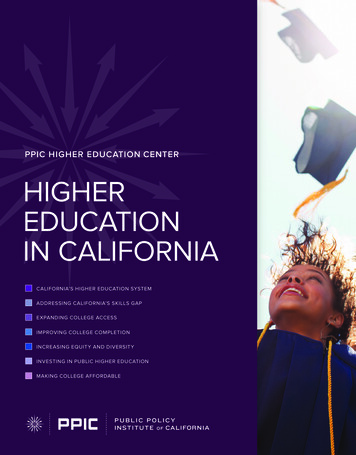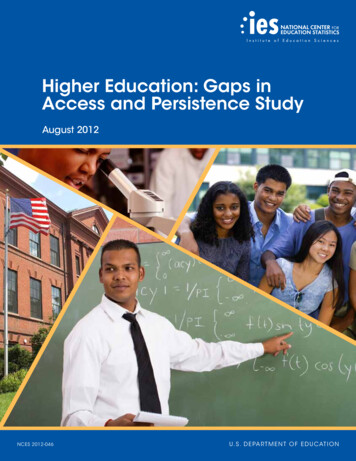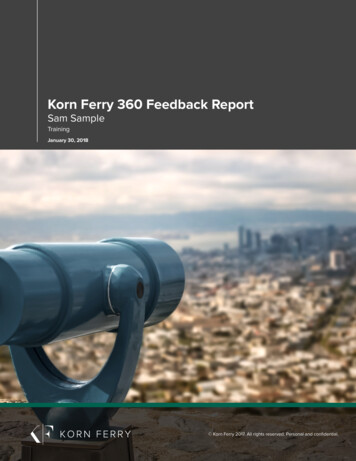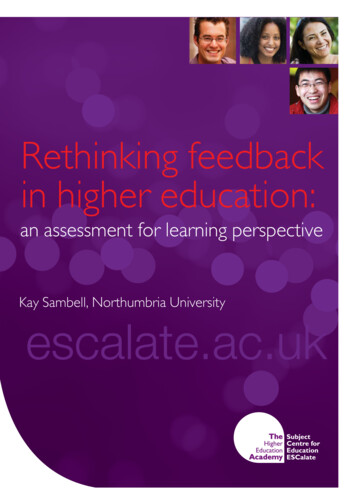
Transcription
Rethinking feedbackin higher education:an assessment for learning perspectiveKay Sambell, Northumbria University
About the authorKay Sambell currently works at Northumbria University, where she is Professor of Learning & Teachingwithin the School of Health, Community and Education Studies. She teaches and undertakes research in theinterdisciplinary area of Childhood Studies and is co-author of Studying Childhood and Early Childhood atUniversity: a guide for students (Sage, 2nd edition, 2010).Kay has a long-standing interest in enhancing assessment to promote learning in higher education and haspublished widely on the impact of assessment on students’ experiences of learning. She was awarded aNational Teaching Fellowship in 2002 for her practice and scholarship in this field and continues to use herown classrooms as sites for ongoing pedagogic development, enquiry, critique and evaluation.As Director of Assessment for Learning (AfL) Enhancement in Northumbria University’s Centre forExcellence in AfL Kay recently led the development of a range of innovative approaches to assessment forlearning practice. In 2009 she was invited to contribute to the work of the Osney Grange Group, a group of23 researchers and writers with specialist expertise in the field of assessment, who were brought togetherby Oxford Brookes’ Assessment Standards Knowledge exchange (ASKe) Centre for Excellence to producean Agenda for Change with regard to feedback policy and practice.Kay is an experienced conference speaker and is often invited to offer keynotes, seminars and workshops atuniversities across and beyond the UK. Her particular interests currently include: improving the first-yearexperience of teaching, learning, assessment & feedback; involving experienced students as ‘learning leaders’;student engagement; student publications and staff-student partnerships.Published byESCalateHEA Subject Centre for EducationUniversity of BristolGraduate School of Education35 Berkeley SquareBristol, BS8 1JAEmail: heacademy-escalate@bristol.ac.ukwww.escalate.ac.uk Kay Sambell and ESCalate July 2011ESCalate production team - Lyndsay Grant and Teresa NurserPermission is granted to copy and distribute this document in unalteredform only, for the purposes of teaching, research, private study, criticismand review, provided that the original author and publisher isacknowledged.The views expressed in this publication are those of the authors and donot necessarily represent those of ESCalate.
Rethinking feedbackin higher education:an assessment for learningperspectiveKay SambellNorthumbria Universitykay.sambell@northumbria.ac.ukDISCUSSIONS IN EDUCATION SERIES
ContentsIntroduction4Section 1 – An agenda for change6Rethinking assessment to promote learningTowards Assessment for Learning in HEModels of feedback in HEThe Northumbria CETL’s model of Assessment for LearningSome common misconceptions and mistaken assumptions about feedbackSection 2 – Putting formal feedback into practiceFormal feedback and peer reviewPeer-review feedback strategiesStudents’ views of the feedback strategiesFormal feedback and self-reviewSelf-review feedback strategy: developing students’ awareness of self-reviewStudents’ views of the feedback strategiesSection 3 – Putting informal feedback into practiceImproving informal feedback by redesigning classroom activitiesRedesigning classroom activities (Example 1): Students working collaborativelyto build graffiti posters in class time to enhance informal feedbackRedesigning classroom activities (Example 2): Building group summariesof required reading to enhance informal feedbackRedesigning classroom activities (Example 3): Structuring project-workto enhance informal feedbackInformal feedback beyond the classroomUsing authentic assessment to enhance informal feedbackUsing student mentoring to enhance informal feedbackSection 4 – Beyond feedbackUsing exemplars: a case studyTeachers’ views of the illustrative value of the exemplarsTeachers’ views of the importance of students’ active engagement and participationStudents’ views of the value of working on exemplarsThe value of peer feedback and 71922222325252628293132333638394041424648523
DISCUSSIONS IN EDUCATION SERIESIntroductionKay Sambell, Northumbria UniversityUniversity tutors spend a lot of time producingwritten feedback on students’ assessed work but areoften disappointed with the result. Conversely,surveys often indicate that feedback is a problemfrom the student point of view (Krause et al, 2005;Carless, 2006; National Student Survey, 2009). Thisdiscussion paper suggests that to improve the studentexperience of feedback we need to move beyondthe traditional view of feedback as the writtencomments that tutors provide, often ‘at the end’ of amodule, on student work submitted for assessment.The discussion takes place in the context of growingarguments to reframe assessment in higher education(HE) so as to focus on learning rather than simplymeasurement. In particular, it will focus on feedbackfrom the viewpoint of the holistic model ofAssessment for Learning (AfL) developed atNorthumbria University (McDowell, Sambell et al,2006). Our model of AfL is based on our own14empirical research into the student experience ofassessment over a number of years (Sambell,McDowell and Brown 1997; Sambell and McDowell1998; McDowell and Sambell, 1998). This identifiedaspects of assessment that can support learning.In 2005 we were awarded CETL status1, whichenabled us to take this work forward across theuniversity. Over the last five years our model of AfLhas underpinned the review and development ofassessment practice in a wide range of disciplinaryareas. Many of the lecturers who used the model todevelop their assessment practices were very keen toimprove their students’ experiences of feedback. Thispaper will briefly indicate some of the different waysin which staff redesigned their feedback practice as aresult. This will be done to highlight some of thethemes, issues and challenges which relate to the reengineering of feedback practice in the context ofAfL.72 Centres of Excellence for Teaching and Learning (CETLs) were established and funded by the Higher Education Funding Councilfor England in 2005.
RETHINKING FEEDBACK IN HIGHER EDUCATION: AN ASSESSMENT FOR LEARNING PERSPECTIVEThe paper broadly suggests that achieving an overallshift towards AfL requires the development of newperspectives on feedback, amongst staff and studentsalike. A wealth of research into AfL in HE proposesthat:I high level and complex learning is best developedwhen feedback is viewed as a relational processthat takes place over time, is dialogic, and isintegral to the whole process of learning andteaching itselfI valuable and effective feedback can emanate froma variety of sources, but if students do not learnto evaluate their own work, they will remaincompletely dependent on others. The abilitiesand disposition to review one’s own work, andthat of others, are essential graduate attributeswhich HE should foster, because they underpin alearner’s capacity to learn autonomously.(Osney Grange Group, 2009)This discussion paper will particularly focus on theissues and challenges of helping students reframetheir views and definitions of feedback in sympathywith AfL approaches. This is deemed especiallyimportant because, whilst it is widely accepted thateffective feedback has huge potential to enhance andaccelerate learning, we have evidence that somestudents’ conceptions of feedback might be limitingtheir capability to benefit from the range of feedbackavailable to them during their time at university.Helping them develop their ideas about feedback,rather than reinforcing mistaken assumptions andlimited views of feedback, is arguably an importantenterprise, and one to which it is worth devotingtime and energy.From this viewpoint feedback is seen as a processwhich is fully integrated into the learning and teachingprocess, building gradually over time, with activestudent involvement. In practice, this means thatmany of the feedback developments covered in thediscussion do not necessarily focus on ways ofimproving feedback by creating better, faster or morediverse feedback messages. Instead, the discussionwill concentrate on exploring some of the practicalstrategies staff have used to develop the studentexperience of feedback by embedding it in formative,learning-oriented environments. These will bepresented together with some snapshots of staff andstudents’ experiences of the redesigned feedbackpractices. The overall aim is to broadly illustrate someof the possibilities and challenges that emerged whendifferent feedback strategies were put into practice. Inthis way the paper hopes to stimulate discussion andprovide food for thought for busy practitioners,rather than offer a comprehensive and detailedsummary of the vast body of work in this complexarea.This paper will be structured in four main sections.Section 1 discusses some new perspectives onfeedback to emerge from recent agendas forchange in relation to assessment and feedback inHE.Section 2 considers ways of putting formalfeedback into practice.Section 3 considers ways of putting informalfeedback into practice.Section 4 looks at ways of moving ‘beyondfeedback’ (Sadler, 2010). This section focuses oneducational practices designed to help learnerscomprehend and develop important assessmentrelated concepts.5
DISCUSSIONS IN EDUCATION SERIESSection 1 - An agenda for change‘Assessment is a central feature of teaching and the curriculum. It powerfully frames howstudents learn and what students achieve. It is one of the most significant influences onstudents’ experience of higher education and all that they gain from it. The reason for an explicitfocus on improving assessment practice is the huge impact it has on the quality of learning.’(Boud and Associates, 2010:1)Rethinking assessment to promote learningThis discussion of feedback is firmly rooted in thecontext of growing arguments to reframe assessmentin HE so as to focus on learning and the support ofstudent achievement rather than simplymeasurement.Since the 1990s research has drawn attention to thedifferent purposes that assessment can serve. Broadlyspeaking, it can:ICertify and measure student learningFrom this perspective assessment’s main purposeis to provide information for others about theextent to which students have learned something,or how their work compares with that of otherstudents. Information often takes the shape of ascore or data which converts to some sort ofqualification. Seeing assessment through this lensis epitomised by the phrase ‘assessment oflearning’.IHelp students improve their learningFrom this perspective assessment’s main purposeis to provide information to students themselves.This information – feedback – can help keep6them on the right track, helping them progressand succeed by helping them identify any gapsbetween current performance and requiredachievement. Viewing assessment through thislens might be captured by the term ‘assessmentfor learning’. The work of Black and Wiliam(1998) has been influential in this respect.IEquip students to be able to undertakelearning and assessment independently oftheir teachers after they have left a formaleducational settingFrom this viewpoint the purpose of assessment isto foster the kinds of attitudes and dispositions, aswell as the skills and knowledge that learners willneed to tackle the kinds of tasks and challengesthey are likely to face throughout their lives. Thisfuture-focused view of assessment is conveyed bythe term ‘sustainable assessment’ (Boud, 2000).Researchers have argued, though, that assessment inHE has typically been so distorted by an overemphasis on the purposes of certification and thejustification of grades and awards that the corepurposes of supporting learning – the formativepurposes of assessment – have become obscured
RETHINKING FEEDBACK IN HIGHER EDUCATION: AN ASSESSMENT FOR LEARNING PERSPECTIVE(see, for instance, Birenbaum, 2003; Segers, Dochyand Cascaller, 2003; Boud and Associates, 2010;Carless et al, 2006).Towards Assessment for Learning in HEIn overall terms, then, AfL is about trying to achieve areappraisal of the role of assessment. It involves tryingto ensure that our conception of assessment movesbeyond that of testing what has been taught, ormeasuring learning outcomes, to encompass viewswhich allow students to benefit from assessment andwhich develop their capacities to become effectiveassessors of their own and others’ work. This meansthinking about assessment activities in a new frame,or seeing assessment through new lenses.The idea that learning is something done by students,rather than to or for them, has undoubtedly been amain driver of AfL reform in HE. Once it is acceptedthat learning is an active, dynamic process, in whichstudents learn by actively making connections andorganising learning into meaningful concepts andunderstandings (Barkley, 2009) then it follows thatapproaches to assessment and feedback need tochange in line with this. For many researchers in HE, amore active, informed and participative role forstudents in the assessment process has usually beendeemed to be key (Price et al, 2008). For example, alarge body of research work and innovation hasfocused on involving students in the assessmentprocess itself, often through the resources of self andpeer assessment, as a vital means of empoweringthem to take control of their own learning, ratherthan remaining dependent on others to evaluate theirlearning for them (Boud, 1995; Nicol, 2009).The definition of formative assessment proposed bySadler (1989) has been very widely used andaccepted as a basis for AfL practice in universities.Sadler states that formative assessment must enablestudents to understand the goals or standards to beachieved and their own current level of performance,and then guide them in taking action to close the gap.This requires students to develop ‘expertise’ in orderto make effective judgements about their ownperformance. Consequently significant emphasis hasbeen placed on the ways in which self and peerassessment can act as a learning tool, supportingstudents to make effective and informed judgements(Bloxham and West, 2007; Rust et al, 2005). Fromthis perspective, involving students explicitly in theassessment process entails helping students todevelop their pedagogic and assessment literacy,as well as supporting them to develop appropriateways of thinking and practising (Meyer and Land,2005) within the specific subject domain. Bloxham(2008) suggests that the phrase ‘assessment aslearning’ might best represent the idea that studentsshould be supported to do assessment, not just beassessed. This conveys the central role that learners,not just their teachers, should play in effectiveassessment environments.7
DISCUSSIONS IN EDUCATION SERIESModels of feedback in HEHE has some well-developed conceptual models thathave been specifically designed to help us improveour formative assessment environments andfeedback practices (see, for example, Gibbs andSimpson, 2005; Hounsell, 2007). In 2006, Nicol andMacFarlane-Dick re-interpreted and synthesised theresearch on formative assessment and feedback tooffer a set of guiding principles for assessment andfeedback that have learner self-regulation at the core.Self-regulation is interpreted as the extent to whichstudents can monitor and evaluate aspects of theirown learning behaviours, and then act on thisinformation to improve their learning. Nicol andMacFarlane-Dick’s model describes the process ofstudent self-regulation from the initial assessment taskand review of current knowledge, to individualinterpretation and formulation of learning tasks, tothe generation of both internal and external goals.The authors contend that the outcomes which arethen produced generate internal feedback whichenables the student to re-evaluate goals, criteria andstandards, and then compare the current stage oftheir own learning/understanding to the externalstandards/goals/outcomes which they wish toachieve.8Nicol and MacFarlane-Dick’s feedback principles havebeen widely disseminated across the sector. Theyinclude:1. clarifying what good performance is2. facilitating reflection and self assessment inlearning3. delivering high-quality feedback informationthat helps learners self-correct4. encouraging teacher-learner and peerdialogue5. encouraging positive motivational beliefs andself esteem6. providing opportunities to act on feedback7. using feedback from learners to improveteaching(Nicol and MacFarlane Dick, 2006).In later work, Nicol’s REAP project (2009) extendedthese principles, establishing clear links to summativeas well as formative assessment design. The newprinciples also brought into focus the importance oflearning communities in enhancing engagement andachievement, and of choice and diversity inassessment methods. The significance of closing thefeedback loop, ensuring that feedback information isattended to and acted upon, was also reinforced.
RETHINKING FEEDBACK IN HIGHER EDUCATION: AN ASSESSMENT FOR LEARNING PERSPECTIVEAfter all, feedback can only serve a formative functionand serve learning fully ‘if it involves the evoking ofevidence and a response to that evidence by using itin some way to improve the learning’ (Black et al,2003, 122).Finally, it is interesting to observe that in universities amajor focus has been on developing ways of givingfeedback on student work and encouragingconstructive use of feedback by students (see, forexample, Gibbs and Simpson, 2005). This contrastswith the priorities of AfL in compulsory schooling,where emphasis has been laid instead on teacherdevelopment focused on classroom practices,building in opportunities for dialogue, enquiry andappropriate questioning (Black et al, 2003). A key aimin the school sector has been to integrate a holisticview of formative assessment with classroompedagogy that develops students’ cognitive abilitiesand deep forms of learning within clearly definedsubject domains (Black and Wiliam, 1998; Black et al,2003). Within this framework formative assessment isa pedagogic approach encompassing a range ofactivities which are undertaken by teachers and/orstudents which provide information that can be usedas feedback. This feedback is used to modify thelearning or teaching activities in which stakeholdersare engaged (Black and Wiliam, 1998).The view of formative assessment as part of goodclassroom practice, ‘involving interactive dialoguewhere the teacher can explore and steer by sensitivechallenge’ (Black and McCormick, 2010: 497) is amuch less prominent view in HE. Angelo and Cross(1993) have, however, explicitly promoted thisapproach in universities, using the term ‘classroomassessment’. They see classroom assessment, whichthey envisage taking place in large lecture formats, aslearner-centred, teacher-directed, mutually beneficial,formative, context-specific, ongoing and firmly rootedin good pedagogic practice.The Northumbria CETL’s model ofAssessment for LearningFor us, AfL is about trying to establish a new balancein assessment which helps address the current overemphasis on summative testing. Of course werequire summative assessment which is rigorous andmaintains standards. But we also urgently requiremanageable, cost-effective strategies for developinglearning-oriented or formative assessment whichpromotes student engagement, is embedded inteaching and learning, provides feedforward ratherthan retrospective feedback, and is a positive force inhelping students to achieve their potential.9
DISCUSSIONS IN EDUCATION SERIESOur experience and research has led us to synthesisesix key conditions for the support of AfL, through alearning environment that:1. Is rich in formal feedback: via, for example,tutor comment; self assessment systems2. Is rich in informal feedback: through, forinstance, dialogic teaching, peer interaction andcarefully designed classroom assessment whichprovides students with a continuous flow offeedback on ‘how they are doing’3. Emphasises authentic assessment: tasksare relevant and meaningful in some way, beyond‘just acquiring marks’4. Offers opportunities for low-stakesassessment practice: students try out andpractise knowledge, skills and understanding beforethey are summatively assessed1. Is rich informalfeedback6. Balancesformative andsummativeassessment5. Developsstudents’independenceand autonomy5. Develops students’ independence andautonomy: students learn to evaluate their ownprogress and direct their own learning6. Balances formative and summativeassessment: high stakes summative assessmentis used rigorously but sparingly(see Figure 1)The six conditions act as interlinking pedagogicprinciples which can be used to inform thedevelopment of effective AfL practice and harnessthe power of assessment to support learning. A keypurpose of our approach is to foster studentdevelopment in taking responsibility for evaluating,judging and improving their own performance byactively using a range of feedback. These capabilitiesare at the heart of autonomous learning and of thegraduate qualities valued by employers and inprofessional practice.2. Is rich ininformalfeedback3. Emphasisesauthenticassessment4. Offersopportunitiesfor low-stakesassessmentpracticeFigure 1: Characteristics of a learning environment that supports Assessment for Learning10
RETHINKING FEEDBACK IN HIGHER EDUCATION: AN ASSESSMENT FOR LEARNING PERSPECTIVESo for us AfL is not only about the quality andtimeliness of feedback tutors give as mandated byuniversity systems – although this is important.Students benefit from assessment which enables themto judge for themselves how they are doing and offersthem opportunities to improve. In addition to teacherwritten feedback ‘at the end’, students require differentforms of feedback from tutors and others during amodule; they also need interaction with fellowstudents which provides informal feedback and abroadening of ideas and possible strategies to movelearning forward.The balance between formative and summativeassessment is important, so students are not mainlydriven by an instrumental hunt for marks. AfL does notuse summative assessment and the acquisition ofmarks as the main driving factor. Instead, the focusshifts towards learning where students haveopportunities to test out ideas, practise relevant skillsand rehearse subject knowledge before these aresummatively assessed.Importantly, we know that students discriminatebetween assessment tasks that are ‘just hurdles tojump’ and those which are ‘relevant’ or feel authenticin some way. Authenticity may be gauged againstactivities which are likely to be useful in the worldoutside HE, such as in employment. It may also be thatan activity is viewed as relevant because it givesstudents a sense that they are personally developing,progressing and learning something worthwhile.This all means that both summative and formativeassessment must be well-constructed and designed,and there may in fact be considerable slippagebetween the two within the learning environment(Taras, 2008). In other words, AfL is not just aboutformative assessment, especially as many practitionerssimply think of formative assessment as giving studentsbetter feedback, allowing them to practise or polishtheir assignment, or doing work that ‘doesn’t count’.Instead, from our viewpoint, the overall assessmentstrategy must employ a diversity of methods to assessgenuine and valued learning. AfL requires appropriateassessment tasks – methods which stimulate andevaluate worthwhile learning throughout the learningprocess, so that students are supported to devotetime and energy on educationally purposeful activity asthey build knowledge and understanding (Gibbs andSimpson, 2005; Nicol, 2009; Kuh et al, 2005).Authentic assessment tasks will replicate as far aspossible the ‘real’ subject, so that students areencouraged to learn to think and practise (Meyer andLand, 2005) in ways which develop students’ cognitiveabilities and critical independence within definedsubject domains (Black and Wiliam, 1998).Appropriate assessment tasks must also foster thecapabilities and dispositions for learning in professionaland personal life beyond graduation, as learning for thelonger term (Carless et al, 2006).AfL encourages students to take responsibility fordirecting their own learning and therefore we need toinclude specific components that will help students tounderstand the standards and criteria that embodywhat it means to do well in the subject, so that theyare in a position to make informed decisions andevaluate their own work during the act of producing it.Our formulation of AfL is congruent with Sadler’s(1998) view of a new ‘learning culture’ whichencompasses: engaging students through appropriatetasks; providing plentiful feedback, including throughthe resources of self and peer assessment; and anunderpinning commitment to improve learning for all.Some common misconceptions and mistakenassumptions about feedbackI will now turn to consider some commonmisconceptions and limited ways of thinking aboutfeedback. It is important to discuss these, partly to tryand avoid them fuelling our own feedback practices,11
DISCUSSIONS IN EDUCATION SERIESand partly to help our students move away from therestrictive models of feedback they often hold whenthey come to university.In everyday university discourse, the feedback form, asa post-facto written comment sheet, has largelybecome synonymous with feedback. This means thatfeedback is often seen as a product (Price et al, 2011),which teachers deliver, and/or an event, whichtypically comes at the end of learning, and is tied upwith students receiving a grade.While students often claim to appreciate and valuethis kind of feedback, there is surprisingly littleevidence that this type of feedback has ‘made adifference’ to the quality of the work studentsproduce (Hounsell et al, 2010; Price et al, 2010).Instead of uncovering significant benefits, research hastended to identify problems arising due to academics’feedback messages being lost in translation, withstudents misunderstanding them, not being able toaccess the language in which guidance is couched, orfailing to heed or act upon important advice (Higginset al, 2001; Glover and Brown, 2006; Chanock, 2000;Lillis and Turner, 2001; Price et al, 2010).In addition, there are issues about the timeliness ofthis traditional type of feedback, which comes too lateto enable students to improve their performance(Higgins et al, 2002). Laurillard (1993) makes a usefuldistinction between ‘extrinsic’ feedback thatconstitutes a commentary subsequent to the action,and ‘intrinsic’ feedback which takes place within thecontext of the action. Obviously the latter seemsmore useful in terms of enabling change and futureaction, but most feedback sheets are received bystudents at the end of a module.Further, by offering a summary judgment (such as amark or grade) traditional feedback forms tend toposition this kind of ‘official’ feedback strongly within a12measurement rather than a learning paradigm. Thismight actually distract a student from engaging withany developmental function the feedback has beendesigned to offer (Black and Wiliam, 1998). Moreover,Bloxham (2009) has pointed out how the traditionalfeedback form is, from the lecturer’s perspective,inevitably often linked to accountability and qualityassurance, which might mean the feedback-giveractually has as much of an eye on the externalexaminer and a perceived need to defend and justifythe grade awarded (Price et al, 2011), as on thestudent for whom the feedback is, ostensibly, crafted.After all, feedback forms are often the main source oftangible evidence that appropriate feedbackmechanisms are in place on our courses.But arguably the most important limitation is if this kindof feedback is regarded, on its own, as being the mainmeans by which students can find out how they aredoing and what they need to do to improve theirwork. In its extreme form, this view of feedback canbecome equated in people’s minds with a linear modelin which tutors are the sole providers of advice andguidance. Here the student’s role is to simply wait toreceive feedback, as it is only after this ‘gift’ has beengiven that they can move forward in their learning. This‘transmission’ model, or feedback-as-telling, reliesexclusively on the tutor dispensing advice, or, perhaps,instructing the student what to do.Where this model of feedback is particularly dominantit may actually encourage students to view themselvesas passive recipients of tutor-given knowledge. It mayalso lead learners to attach an over-riding significanceto the judgements tutors make and the marks theyaward, rather than seeing feedback as havingimplications for their future learning and behaviour.Moreover, it may be the case that the more studentsare ‘told’ how to improve their work, the less likelysome are to develop independent abilities to makejudgements for themselves.
RETHINKING FEEDBACK IN HIGHER EDUCATION: AN ASSESSMENT FOR LEARNING PERSPECTIVEOrsmond and Merry’s (2009) study supports thisassertion and suggests that some students becomeextremely dependent on tutor-written feedback.However, providing more and more of this sort offeedback may simply increase student dependenceon the tutor. In particular, Orsmond and Merry’sresearch discovered that not all students thoughtabout or responded to teacher feedback in the sameway. Non-high achieving students appeared to focuson the detail and ‘surface features’ of feedbackmessages, stating that they had difficulty in relatingcomments to their work, acting on the feedback, andwere confused by feedback that suggested a range ofdifferent approaches. They generally acceptedeverything the tutor suggested and believed that thep
summary of the vast body of work in this complex area. This paper will be structured in four main sections. Section 1 discusses some new perspectives on feedback to emerge from recent agendas for change in relation to assessment and feedback in HE. Section 2 considers ways of putting formal feedback into practice. Section 3 considers ways of .
